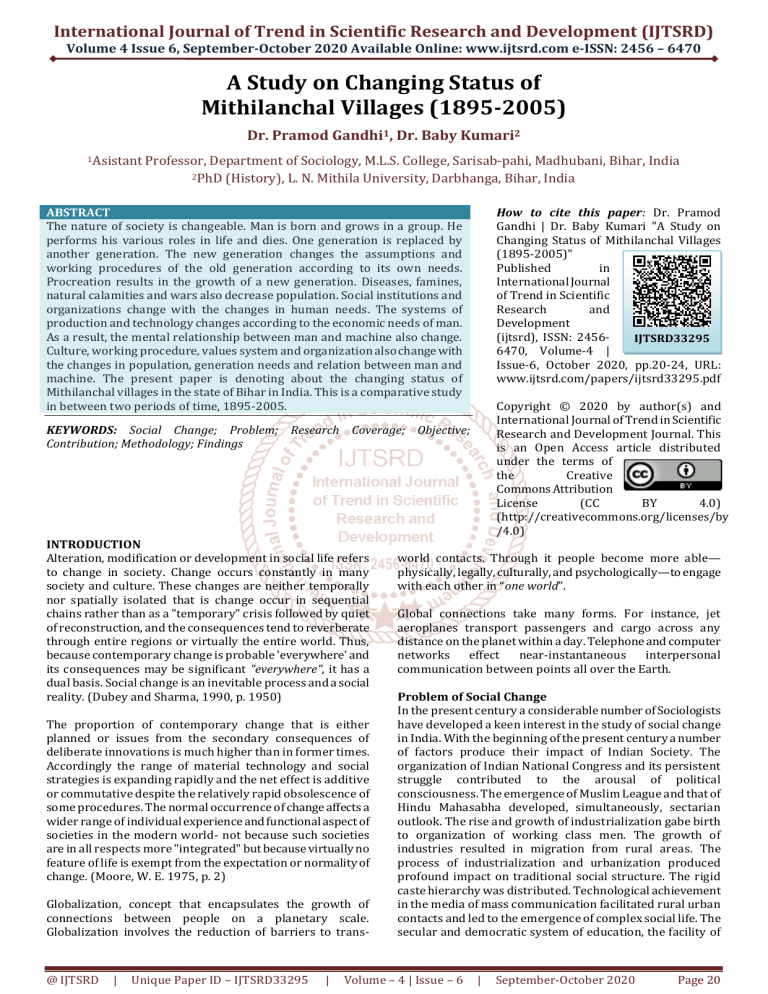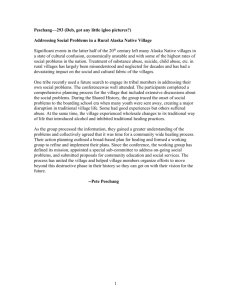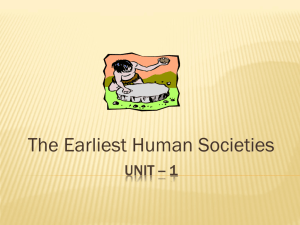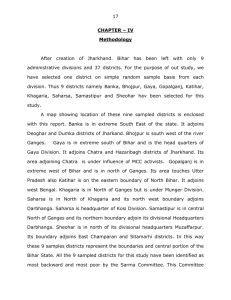
International Journal of Trend in Scientific Research and Development (IJTSRD) Volume 4 Issue 6, September-October 2020 Available Online: www.ijtsrd.com e-ISSN: 2456 – 6470 A Study on Changing Status of Mithilanchal Villages (1895-2005) Dr. Pramod Gandhi1, Dr. Baby Kumari2 1Asistant Professor, Department of Sociology, M.L.S. College, Sarisab-pahi, Madhubani, Bihar, India 2PhD (History), L. N. Mithila University, Darbhanga, Bihar, India ABSTRACT The nature of society is changeable. Man is born and grows in a group. He performs his various roles in life and dies. One generation is replaced by another generation. The new generation changes the assumptions and working procedures of the old generation according to its own needs. Procreation results in the growth of a new generation. Diseases, famines, natural calamities and wars also decrease population. Social institutions and organizations change with the changes in human needs. The systems of production and technology changes according to the economic needs of man. As a result, the mental relationship between man and machine also change. Culture, working procedure, values system and organization also change with the changes in population, generation needs and relation between man and machine. The present paper is denoting about the changing status of Mithilanchal villages in the state of Bihar in India. This is a comparative study in between two periods of time, 1895-2005. How to cite this paper: Dr. Pramod Gandhi | Dr. Baby Kumari "A Study on Changing Status of Mithilanchal Villages (1895-2005)" Published in International Journal of Trend in Scientific Research and Development (ijtsrd), ISSN: 2456IJTSRD33295 6470, Volume-4 | Issue-6, October 2020, pp.20-24, URL: www.ijtsrd.com/papers/ijtsrd33295.pdf Copyright © 2020 by author(s) and International Journal of Trend in Scientific Research and Development Journal. This is an Open Access article distributed under the terms of the Creative Commons Attribution License (CC BY 4.0) (http://creativecommons.org/licenses/by /4.0) KEYWORDS: Social Change; Problem; Research Coverage; Objective; Contribution; Methodology; Findings INTRODUCTION Alteration, modification or development in social life refers to change in society. Change occurs constantly in many society and culture. These changes are neither temporally nor spatially isolated that is change occur in sequential chains rather than as a "temporary" crisis followed by quiet of reconstruction, and the consequences tend to reverberate through entire regions or virtually the entire world. Thus, because contemporary change is probable 'everywhere' and its consequences may be significant "everywhere", it has a dual basis. Social change is an inevitable process and a social reality. (Dubey and Sharma, 1990, p. 1950) The proportion of contemporary change that is either planned or issues from the secondary consequences of deliberate innovations is much higher than in former times. Accordingly the range of material technology and social strategies is expanding rapidly and the net effect is additive or commutative despite the relatively rapid obsolescence of some procedures. The normal occurrence of change affects a wider range of individual experience and functional aspect of societies in the modern world- not because such societies are in all respects more "integrated" but because virtually no feature of life is exempt from the expectation or normality of change. (Moore, W. E. 1975, p. 2) Globalization, concept that encapsulates the growth of connections between people on a planetary scale. Globalization involves the reduction of barriers to trans- @ IJTSRD | Unique Paper ID – IJTSRD33295 | world contacts. Through it people become more able— physically, legally, culturally, and psychologically—to engage with each other in “one world”. Global connections take many forms. For instance, jet aeroplanes transport passengers and cargo across any distance on the planet within a day. Telephone and computer networks effect near-instantaneous interpersonal communication between points all over the Earth. Problem of Social Change In the present century a considerable number of Sociologists have developed a keen interest in the study of social change in India. With the beginning of the present century a number of factors produce their impact of Indian Society. The organization of Indian National Congress and its persistent struggle contributed to the arousal of political consciousness. The emergence of Muslim League and that of Hindu Mahasabha developed, simultaneously, sectarian outlook. The rise and growth of industrialization gabe birth to organization of working class men. The growth of industries resulted in migration from rural areas. The process of industrialization and urbanization produced profound impact on traditional social structure. The rigid caste hierarchy was distributed. Technological achievement in the media of mass communication facilitated rural urban contacts and led to the emergence of complex social life. The secular and democratic system of education, the facility of Volume – 4 | Issue – 6 | September-October 2020 Page 20 International Journal of Trend in Scientific Research and Development (IJTSRD) @ www.ijtsrd.com eISSN: 2456-6470 higher western education and the impact of western culture also proved instrumental in generating a process of change. Moreover, the fight against untouchability and caste inequality, achievement of independence and setting up of parliamentary democratic ideals of secularism and socialism along with mass participation in general elections appeared as modern forces producing changes of various works of social life, attitude, outlook and patterns in social relationship. Structural changes started taking place3 in Indian society. Research Coverage: Theme and Area In India we have about 6.38 lacks villages. In the recent year a national alliance has been formed by wide range of civil society, industrial and academic organizations to harness the power of partner in achieving the goals of mission 2007. (The Hindu, Oct. 18, 2004, p.11). Every village a knowledge centre, at present 72.21 per cent of one billion populations living in 6.38 lacks villages in India. The situation in rural India is as follows: 5.0 per cent of villages do not have pucca houses, 25 per cent have no safe drinking water, 55.0 per cent no electricity in their houses and 85 per cent have no sanitation facilities. (The Hindu, 29 th March, 2004, p.18). If these statistics are fleshed out in human terms, it is not pictures that can any Indian feel proud. A look at the budgetary provision shows that allocation for rural sanitation and safe drinking water does not exceed 2.0 per cent of the total plan expenditure. And what about education- the one major factor that makes such a vast difference? Hardly 60.0 per cent of the rural population is literate and the dropout rate for children is as high as 50.0 per cent well before they reach the fifth standard. Nearly 65.0 per cent of the village do not have a proper school and even where there are schools’, horror stories fo the teacher coming thrice a year just for the record of of the school ‘shed’ being used to store grain and cattle feed are common in the media. Objective of Research Work The present study attempts to diagnose the changes which have been taken place in the village structure of north Bihar especially in the old Bahera revenue Thana during 18952005. The study clarifies the village structure as an important social unit of rural society in north Bihar during the turn of 19th century. It also prepares a profile of present structural pattern of the village of north Bihar. Thirdly, the study arrives at some generalization on the basis of changes between two points of time considering a number of well defined variable relating to social change. Finally, the data relating to social change of the selected villages would be compared with Block, District and State level data. Thus objectives of the study are concentrated on the following item: To understand the village structure as an important social unit of rural society in north Bihar during the turn of 19th century. To prepare a profile of present structural pattern of village of north Bihar. To arrive at some generalizations on the basis of changes between two points of time. To compare these changes with Block, District and State level data. @ IJTSRD | Unique Paper ID – IJTSRD33295 | Contribution of Research Work As the new millennium dawned, all countries resolved in the United Nation General Assembly to work towards eight “Millennium Development Goal (MDG). These are: Eradicate extreme poverty and hunger; Achieve universal primary education; Promote general equality and empower women; Reduce child mortality; Improve material health; Combat HIV/AIDS, Malaria and other diseases; Ensure environmental sustainability and ; Develop a global partnership for development. As Can be seen from the above parameters: health, education, gender, environment, employment from important components of rural development. With 72.21 per cent of the billion population living in 6.38 lacks villages in India, surely the study is very important for the rural India to compete with the globalization world. The study focuses on the different MDG indicators to know the actual position of the villages for implementing the various govt. programmes or improving the human development index formation of “human capital.” The significant development Mission, 2007 in recent months for improving the status of 6.38 lacks villages are praiseworthy. Now it is very important to underline the importance of rural development and urban amenities should be provided to the rural areas to ensure the prosperity of villages. In the light of the above mentioned fact, the study of different factors for improving the quality of life in the rural areas of Mithilanchal is esedential for the social scientists in general and sociologist in particular. The finding would be a great help for the further study as far as the sociologists and economists are concerned. Hence, it would contribute to the knowledge of Bihar’s Sociology. Methodology In a research project, the methodology of the study constitutes an outstanding place. This is supported by the logic that it is a path or device to simplify the process of carrying on the researches. It makes our approach scientific vis-a-vis practical, not only this; it also helps the research scientists especially in respect of substantiating the arguments and testifying the logic. The present research project is a microscopic study where we have gravitated our attention on a particular revenue thana, considered to be more sensitive specially with the viewpoint of studying the problems of regional backwardness in a social setup. It cannot be refuted that the social structure of north Bihar is a bit distinct to the social structure of south Bihar. This is confirmed by the fact that the natural condition, ecological avenues, social environment, socioeconomic disparity and so on and so forth present a distinct picture. We find plethora of differences between their structures and social condition, and so it is considered more rational to select a region which has a number of oscillating trends. In north Bihar, the Darbhanga district, has some outstanding features where we find high magnitude of exploitation and oppression. Not only this, we also find here harmful effects of Volume – 4 | Issue – 6 | September-October 2020 Page 21 International Journal of Trend in Scientific Research and Development (IJTSRD) @ www.ijtsrd.com eISSN: 2456-6470 natural calamities. The poor rate of literacy, the retarded growth in socioeconomic infrastructure and the irrational decision of the state policy makers have crippled the development faculties of the district, Besides, it is a central place in the territorial boundaries of north Bihar. The study uses the descriptive and analytical research design as a fact finding investigation with adequate interpretation. Both quantitative and qualitative techniques are made use for the study. Secondary sources of information are tapped in addition to the responses from interview schedule. Selection of Sampling Frame Keeping in view of the objective of the study, the study confines to villages of Darbhanga district of Mithilanchal. “Village Notes” of Old Bahera revenue thana. At present, we have two sub-divisions in this revenue thana. The two sampled villages are located nearly in the centre of two subdivisions. That's why we have selected these two villages to know the impact of developments programmes and subsequently a change in the structure. Then a fresh schedule has been prepared on the basis of the items found in the "Village Notes" for collection of data from the sampled villages. The schedule has been used for collecting item-wise information from the two sampled village of Bahera revenue thana, whose "Village Notes" have been consulted in the first phase. Tools of Data Collection In the first phase data are collected from “Village Notes” prepared during the turn of 19th century. In these “Village Notes”, data were collected at the time of cadastral survey conducted by the British Rules. In the second phase data are collected from primary and secondary sources with the help of following tools: A. Interview Schedule for primary data; B. Documentary schedule for secondary data. The comparative Changes with Block, District and State Level Data DYNAMICS AND STATIC’S ARE THE TWO FEATURES OF A SOCIAL SYSTEM. Social system develops from the process of establishing a balance between these two. Keeping this in view, August comte divided sociology into social dynamics and social statics. Social dynamics mainly studies social change. Social statics studies the factors related to social continuity and stability. On the basis of the aforesaid facts, it presents a comparative study of the changes with Block, District and State level data, with the help of tabular analysis. Table no.-1 Comparison of distribution of villages (1895-2005) Block, District, State level (2005) : Household caste-wise Manigachhi Benipur Tatuar Amaithi Darbhanga Bihar Block Block Castes 1895 2005 2005 1895 2005 2005 2005 2005 Upper Castes Hindus Intermediate Castes Hindus Lower Castes Hindus Upper Castes Muslims Lower Castes Muslims 50 (25.00) 127 (63.50) 16 (8.00) 00 (0.0) 07 (03.50) 429 (38.34) 521 (46.56) 48 (4.29) 00 (00.00) 121 (10.81) 11353 (34.86) 14330 (44.00) 1823 (5.59) 1307 (4.02) 3756 (11.53) 66 (34.20) 48 (24.87) 52 (26.94) 17 (8.80) 10 (5.19) 350 (36.26) 461 (47.77) 47 (4.87) 84 (8.71) 23 (2.39) 10657 (35.0) 14616 (48.00) 1522 (5.00) 2438 (8.00) 1218 (4.00) 224455 (36.40) 291113 (47.20) 20289 (3.30) 31449 (5.10) 49330 (8.00) 5204321 (37.22) 6666898 (47.68) 503373 (3.60) 699130 (5.00) 908868 (6.50) Total 200 1119 32569 193 965 30451 616,636 13,982,590 Table no.-2 Comparison of distribution of villages (1895-2005) Block, District, State level (2005) : Means of Ploughing facility-wise Manigachhi Benipur Means of Tatuar Amaithi Darbhanga Bihar Block Block ploughing facilities 1895 2005 2005 1895 2005 2005 2005 2005 Old Method (Hal-Bail) 30 (15.00) Tractor 00 No Facility Total @ IJTSRD | 178 (0.54) 59 (0.18) 32332 (99.28) 32 (16.58) 170 (85.00) 25 (2.24) 16 (1.43) 1078 (96.33) 200 1119 32569 Unique Paper ID – IJTSRD33295 | 161 (83.42) 23 (2.39) 11 (0.02) 931 (96.49) 191 (60.62) 67 (0.22) 30193 (99.15) 48446 (7.85) 14731 (2.39) 553459 (89.76) 317324 (2.27) 91304 (0.65) 13573962 (97.08) 193 965 30451 616,636 13,982,590 00 Volume – 4 | Issue – 6 | September-October 2020 Page 22 International Journal of Trend in Scientific Research and Development (IJTSRD) @ www.ijtsrd.com eISSN: 2456-6470 Table no– 3 Comparison of distribution of villages (1895-2005) Block, District, State level (2005) : Housing condition-wise Manigachhi Benipur Tatuar Amaithi Darbhanga Bihar Housing Block Block condition 1895 2005 2005 1895 2005 2005 2005 2005 192 218 20087 186 180 18041 390330 8073465 Kachcha (96.00) (19.48) (61.68) (96.38) (18.65) (59.25) (63.30) (57.74) 02 552 11890 01 472 11945 218969 5792729 Pucca (1.00) (49.33) (36.50) (0.52) (48.91) (39.23) (35.51) (41.43) 06 349 592 06 313 465 7337 116396 Khaprail (3.00) (31.19) (1.82) (3.10) (32.44) (1.52) (1.19) (0.83) Total 200 1119 32569 193 965 30451 616636 13982590 Table – no. 4 Comparison of distribution of villages (1895-2005) Block, District, State level (2005) : Sanitation facility-wise Manigachhi Benipur Tatuar Amaithi Darbhanga Bihar Kinds of Block Block Sanitation 1895 2005 2005 1895 2005 2005 2005 2005 200 698 21599 193 580 21419 489178 11730859 Old System (100.00) (62.38) (66.31) (100.00) (60.11) (70.34) (79.33) (83.89) 421 10970 385 9032 127458 2251731 New system 0 0 (37.62) (33.69) (39.89) (29.66) (20.67) (16.11) Total 200 1119 32569 193 965 30451 616636 13982590 Findings and Conclusion On the basis of data and available literature, the study reveals that in comparison to the past, the village structure of the present is now completely changed. No Doubt, the influencing factors are related to the constitutional and legal provisions. After the attainment of independence, we adopted a new constitution which necessitated a change in the legal provisions and the society in a natural way preferred positive developments. The present study, on the basis of available facts and figures, diagnosed the emerging change in the village structure. In the face of preceding research work, we identify the following changes: The percentage comparison shows castes Hindus gradually increases in Amaithi and gradually decreases in Tatuar up to the Block level. There is decease in the percentage of households of upper castes Hindus on block level. But on the other hand there is increase in the percentage of households of upper castes Hindus on district level and state level. Tere is very little percentage (3.60) of lower castes Hindus on state. The total percentages of households are 11.50 on state level (Based on table no.-1). To enrich the agriculture sector it is not only essential to develop the irrigation facilities but also we have to change in ploughing system. It is obvious from the table pertaining to the data of 2005 that the villages have also modern means of ploughing. On block level there are one fourth tractors in comparison to the ole method, but on district and state level its percentage gradually decreases. Thus, we find that the development of Science and Technology, here as an positive impact the rural society as the farmers are adopting new system of means of ploughing. (Based on table no.-2) The housing condition is and indication of physical characteristics of the village. This affects the network of social relation in a village in many ways. It is also an important variable for understanding the village life. In the past, the maximum number of people was living in the @ IJTSRD | Unique Paper ID – IJTSRD33295 | kachcha houses. In comparison to block level, the percentage of pucca houses decreases on district level but on state level its percentage increases. In comparison to kachcha houses, there is decrease of 16.31 per cent in pucca houses on state level. These type of changes made possible easy and effective communication simplifying the pattern and style of living. This has shown a positive impact on the thinking standard. (Based on table no.-3) Availability of sanitation facilities can’t be underestimated, if we are really interested in establishing a suitable nexus for the development of personalities. In the name of sanitary facility on the basis of block level it is 29.66 per cent, on the basis of district level it is 20.67 per cent, but on the basis of state level it 16.11 per cent. It has been seen that 83.89 per cent households have no sanitation facilities in the state. For sanitation, in the villages, people used to go to the fields, gachhi on side of tank of river. The scene of 19th century clears that neither the voluntary social organization nor the policy makers were interested in developing the sanitary facilities in the changed scene; most of the household have new method of sanitation. (Based on table no. 4) On the basis of aforesaid findings, the following points emerge: Change in natural phenomenon. The process of change in influenced by a number of factors. The structural formation of a village is substantially influenced by the constitutional provision. A major change in the structure of Indian village is apparent. The counters of development have undergone radical changes during the yester decade. A change in the development process has considerably been influenced by the changing level of social transformation. The scientific developments vis-à-vis the instrumentality of sophisticated information technologies have fantastically influenced the process of change. Volume – 4 | Issue – 6 | September-October 2020 Page 23 International Journal of Trend in Scientific Research and Development (IJTSRD) @ www.ijtsrd.com eISSN: 2456-6470 References [1] Dubey and Sharma, (1990), “Sociology: Introduction”, New Delhi, NCERT, 1990, p. 195. An [2] Moore, W. E., (1975) “Social Change”, Eastern Economic Edition, New Delhi, Prentice Hall of India, p.2 [4] The Hindu, March 29, 2004, New Delhi. [5] Village Notes, (1895), The “Village Note Form”, was prepared in the litter no. 1518, dated 14th May, 1895 from Director of land records addressed to superintendent, Government Printing, Bengal. [3] The Hindu, Oct. 18, 2004, New Delhi. @ IJTSRD | Unique Paper ID – IJTSRD33295 | Volume – 4 | Issue – 6 | September-October 2020 Page 24






